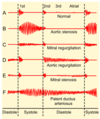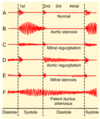Cardiac Valve Defects Flashcards
Cardiac valve defects may be incompetent (regurgitant), stenosed or both. Abnormal valves produce turbulent flow which can be heard as a murmur on auscultation; a few murmurs are also felt as a thrill on palpation.
What is the S1 heart sound?
- closure of mitral + tricuspid valves at start of isovolumetric contraction
- VP > AP -> so AV valves close
- valves open during end of diastole
- soft if long PR or mitral regurgitation
What is the S2 heart sound?
- closure of aortic + pulmonary valves
- AortaP + Pulmp > ventricularp -> semilunar valves close
- splitting during inspiration is normal
What is the S3 heart sound?
- third heart sound - ‘ventricular gallop’
- ‘kentucky gallop’ - (S1 - Ken, S2 - tuck, S3 - y)
- caused by diastolic filling of ventricle
- considered normal if < 30 yrs old (may persist in woman up to 50y)
- heard in left ventricular failure (eg. dilated cardiomyopathy), constrictive pericarditis (aka pericardial knock) and mitral regurgitation
What is the S4 heart sound?
- occurs just before S1 only if pathology present
- ‘atrial gallop’
- caused by atrial contraction against a stiff ventricle
- may be heard in aortic stenosis, HOCM + hypertension
- in HOCM a double apical impulse may be felt as a result of a palpable S4
S3 and S4 may occur together in what is known as a quadruple gallop or may merge to produce a summation gallop S7
What are examples of ejection systolic murmurs?
- aortic stenosis
- pulmonary stenosis, HOCM
- ASD, Fallot’s

What are examples of pansystolic/holosystolic murmurs?
- mitral/tricuspid regurgitation (high-pitched + ‘blowing’ in character)
- VSD (‘harsh’ in character)

What are examples of late systolic murmurs?
- mitral valve prolapse
- coarctation of aorta

What are examples of early diastolic murmurs?
- aortic regurgitation (high pitched + ‘blowing’ in character)
- Graham-Steel murmur (pulmonary regurg, again high pitched + ‘blowing’ in character)

What are examples of mid-late diastolic murmurs?
- mitral stenosis (‘rumbling’ in character)
- austin-flint murmur (severe aortic regurgitation, again rumbling in character)

What is an example of a continuous machine-like murmur?
patent ductus arteriosus

What are the signs and symptoms of aortic stenosis and what is characteristic of this specific murmur?
- ejection systolic murmur - right 2nd ICS
- crescendo-decrescendo
- radiates to carotids bilaterally
- pitch = medium
- symptoms*: dyspnoea, angina, exertional syncope, systemic emboli, sudden death
- signs: slow rising carotid pulse, narrow pulse pressure, displaced, thrusting apex beat, soft S2 (absent S2 in severe disease), brachio-radial delay, late + weak pulse
*(SAD = syncope, angina, dyspnoea)
What are common causes of aortic stenosis?
- cusp calcification of bicuspid aortic valve - calcification develops approx 30yrs w/ progressive stenosis, thought that years of turbulent flow across abnormal valve disrupt endothelium and collagen matrix of leaflets, resulting in gradual calcium deposition
- age-related calcification of the normal tricuspid aortic valve - normal aortic valve is tricuspid where about 1-2% of pop have a bicuspid valve, it is thought cumulative wear + tear of valve motion over many years leads to endothelial + fibrous damage, causing calcificiation of an otherwise normal valve
- post rheumatic fever valve disease (rare in UK)
- congenital: William’s, Turner’s
What is the pathophysiology of aortic stenosis?
- blood flow across aortic valve is impeded during systole
- as a consequence, significantly elevated left ventricular pressure is necessary to drive blood into aorta
- since AS develops over chronic course, the LV is able to compensate by undergoing hypertrophy in response to the higher systolic pressure it must generate to maintain output
- ie. gradual development of LV outflow obstruction causes gradual pressure overload of LV + results in compensatory LV hypertrophy
- however, hypertrophy reduces compliance of ventricle -> resulting elevation of diastolic** pressure -> **LA hypertrophy in order to fill the ‘stiff’ LV
as a consequence of the compensatory changes, there is a long asymptomatic period - eventually, the heart decompensates and there is deterioration in cardiac function leading to development of symptoms.
What are relevant investigations for aortic stenosis?
- transthoracic echocardiogram - best for initial + subsequent evaluation of AS, used when there is an unexplaine dsystolic murmur, a single second heart sound, a history of a bicuspid aortic valve or symptoms that might be due to AS -> it shows elevated aortic pressure gradient
- ECG - may show LVH and absent Q waves, AV block, hemiblock or bundle branch block
- cardiac catheterisation - useful for diagnosis only when echo is inconclusive, shows elevated aortic pressure gradient
What does left ventricular hypertrophy look like on an ECG?
- Results in increased R wave amplitude in the left-sided ECG leads (I, aVL and V4-6) and increased S wave depth in the right-sided leads (III, aVR, V1-3)
- The most commonly used criteria are the Sokolov-Lyon criteria (S wave depth in V1 + tallest R wave height in V5-V6 > 35 mm)
- ST segment depression and T wave inversion in the left-sided leads: AKA the left ventricular ‘strain’ pattern
- Left axis deviation also common

What is the management of aortic stenosis in a clinically stable patient who is asymptomatic?
-
severe AS:
- referral for surgical valve replacement if EF <50%
- when surgery not performed, pts w/ severe AS should have echo every 6-12 months + regular clinical follow-up
-
non-severe AS - undergoing no surgery:
- serial transthoracic echos every 3-5 years (mild AS) and 1-2 years (moderate AS)
-
non-severe AS - undergoing bypass, valve or aortic surgery:
- concomitant prophylactic valve replacement
What is the management of aortic stenosis for clinically stable patients who are symptomatic?
- surgical aortic valve replacement - STS-PROM and EuroScore II are two risk assessment tools helpful for individual patient’s operative risk, valve replacement appropriate therapy for most symptomatic pts w/ severe AS, prosthetic aortic valves used in surgical valve replacement may be mechanical or bioprosthetic
- long-term infective endocarditis antibiotic prophylaxis
- long-term anticoagulation - in those pts who have had aortic valve replacement using prosthetic mechanical valves, not required if bioprosthetic valves used except in presence of AF
What are the causes of mitral regurgitation?
- MV prolapse
- congenital cleft leaflets
- MV annulus calcification
- heart failure
- Marfan’s
- HOCM
- MI
- myxoma
- papillary muscle rupture
- overload
What are the signs and symptoms of mitral regurgitation and what is characteristic of this specific murmur?
- pansystolic - left 5th ICS
- continuous character
- radiates to left axilla
- high pitch
-
symptoms:
- acute - severe dyspnoea due to pulm oedema,
- chronic - fatigue + exertional dyspnoea (allowing heart to compensate)
- signs: soft S1, presence of S3, displaced thrusting apex beat
What is the management of mitral regurgitation?
- AF → control rate if fast + anticoag
- Acute → nitrates / diuretics / positive inotropes
- Severe → SURGERY
- Repair over replacement is strong in degenerative regurgitation
What are the signs and symptoms of tricuspid regurgitation and what is characteristic of this specific murmur?
- pansystolic murmur - left 4th ICS
- continous character
- low pitch
- symptoms: fatigue, symptoms of RVF
- signs: signs of RVF
What are the signs and symptoms of pulmonary stenosis and what is characteristic of this specific murmur?
- ejection systolic murmur - left 2nd ICS
- crescendo-decrescendo
- radiates to left side of neck
- medium pitch
- symptoms: asymp, fatigue, syncope
- signs: cyanosis
Can be caused by Noonan syndrome, rheumatic fever and carcinoid syndrome
What are the causes of aortic regurgitation?
- supravalvular aortic root disease
- Marfan’s
- CTD
- atherosclerosis
- dissecting aneurysm
- bicuspid valve
- infective endocarditis
What are clinical features of aortic regurgitation?
- High-pitched early diastolic murmur
- collapsing pulse + wide pulse pressure
- heaving apex
- Quincke’s sign → capillary pulsation in nail beds
- De Musset’s sign → head nodding w/ each heart beat
- Corrigan’s sign → carotid pulsation
Usually presents w/ LV failure
Ix → ECG, CXR, ECHO, Cardiac catheterisation
What is the management for aortic regurgitation?
- Main goal is to reduce systolic HTN → ACE inhibitors
- Echo every 6-12 months
Indications for surgery:
- severe AR w/ enalarged ascending aorta
- Increasing symptoms
- Enlarging LV or deteriorating LV function on ECHO
What is the biggest cause of mitral stenosis?
Rheumatic fever
What is the clinical presentation of mitral stenosis?
- Pulmonary HTN related
- Dyspnoea, haemoptysis, chronic bronchitis-like picture
- Hoarseness + dysphagia
- Malar flush, low-vol pulse
- AF common (due to enlarged LA)
Ix → ECG (p-mitrale), CXR, ECHO
What is the management of mitral stenosis?
- If in AF → rate control crucial
- Anticoagulate w/ warfarin
- Diuretics reduce preload and pulmonary venous congestion
- If above fails to control symptoms → balloon valvuloplasty, open mitral valvotomy, or valve replacement


